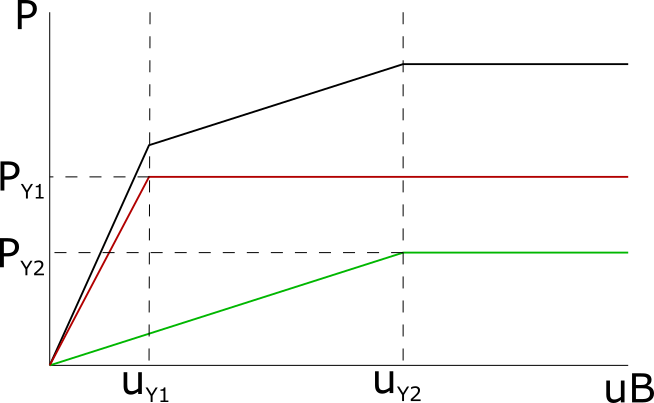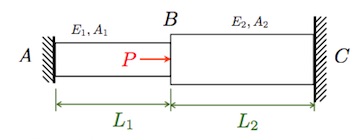From Hooke's Law, we know that
$$\epsilon = \dfrac{\sigma}{E}$$
This is valid up until the yield point. Considering a perfectly plastic material, the deformation $\epsilon$ is constant after the yield point, which gives us the following graph:

So, to answer your question, what is the value of $u_{Y_1}$? Well, it is equal to the displacement under the yield stress:
$$u_{Y_1} = \dfrac{\epsilon}{L} = \dfrac{\sigma_{Y_1}}{E_1L_1}$$
Likewise for $P_{Y_1}$:
$$P_{Y_1} = \sigma_{Y_1}A_1$$
Now, for the rest of the question, I think it is worth expanding your equation:
$$P = \dfrac{E_1A_1u_B}{L_1} + \dfrac{E_2A_2u_B}{L_2}$$
This is equivalent to
$$P = \sigma_1A_1 + \sigma_2A_2 = P_1 + P_2$$
(where $\sigma_1$ and $\sigma_2$ are variables and proportional to $u_B$) which means that the force applied is equal to the sum of the forces applied by each member, which each are equal to the product of the stress and the area of the member. Keep that in mind.
Now, the question states that we can assume that AB will become plastic first. So we know that the situation will change when $u_B = u_1$. In this case, the equation above will change to
$$P = \sigma_{Y_1}A_1 + \sigma_2A_2 = P_{Y_1} + \dfrac{E_2A_2u_B}{L_2}$$
So, as of that point, member AB will no longer increase how much it resists deformation; it is no longer proportional to $u_B$, but is instead a constant equal to $P_{Y_1} = \sigma_{Y_1}$. Member BC, however, has yet to yield, and therefore remains proportional to $u_B$.
As the force increases, $u_B$ will eventually reach $u_2$, at which point BC's collaboration will also become a constant and equal to $P_{Y_2}$, so we have
$$P = \sigma_{Y_1}A_1 + \sigma_{Y_2}A_2 = P_{Y_1} + P_{Y_2}$$
This tells us that once both members cross into the plastic region, the deformation will tend to infinity.
So, there's your answer:
$$P = \begin{cases}
\begin{aligned}
&\left(\dfrac{E_1A_1}{L_1} + \dfrac{E_2A_2}{L_2}\right)u_B &&\text{ for }u_B \in [0, u_1] \\
&\sigma_{Y_1}A_1 + \dfrac{E_2A_2}{L_2}u_B &&\text{ for }u_B \in [u_1, u_2] \\
&\sigma_{Y_1}A_1 + \sigma_{Y_2}A_2 &&\text{ for }u_B \geq u_2
\end{aligned}
\end{cases}$$
Which gives you the following behavior (the red line shows AB's contribution and the green, BC's; the black is the entire structure's resistance and is equal to the sum of both lines):




